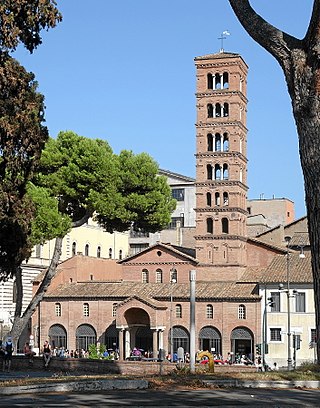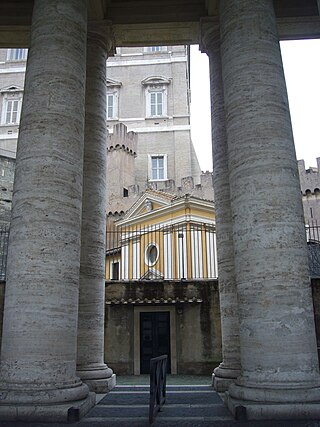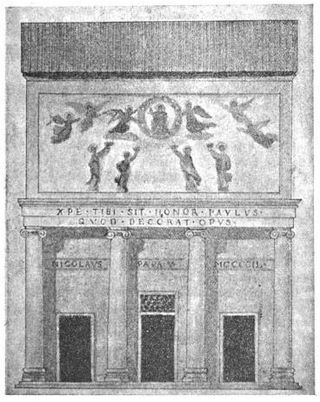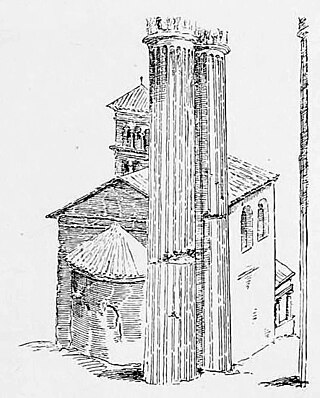
San Menna (Italian: Saint Menas) was an ancient church in Rome, formerly located along the Via Ostiensis which led to the Basilica of Saint Paul. It appears to have been destroyed at some point after the tenth century.

San Menna (Italian: Saint Menas) was an ancient church in Rome, formerly located along the Via Ostiensis which led to the Basilica of Saint Paul. It appears to have been destroyed at some point after the tenth century.
In the eighth century, the anonymous pilgrim of Einsiedeln pointed out that there existed a church dedicated to the Egyptian martyr Saint Menas on the Ostian Way, a little before reaching the Basilica of Saint Paul. [1] [2] The church was connected to the famous portico that led from Porta San Paolo into the Ostian Basilica, as is evidenced from the pilgrimage itineraries of the seventh century: inde per porticum usque ad ecclesiam Mennae, et de Menna usque ad s. Paulum Apostolum. [1] [2] [note 1] A precise location for the church may be next to a small bridge (ponticello) along the porticus that spanned the Almone, a small river that used to flow into the Tiber from the east, but is today diverted. [3]
The church was one of a series of auxiliary structures that were built along the porticus on the Via Ostiensis. These included an oratory to Saint Euplius, which had been founded by Pope Theodore I (642–649) next to the gates, and a chapel dedicated to Saints Peter and Paul built by Pope Donus (678–678), which was later connected to the legendary meeting between the two saints before their martyrdom. [3]
On the Wednesday after the fourth Sunday of Lent, when the station is held at the Basilica of Saint Paul, the collecta was held at this church of San Menna, [1] meaning that the people and ministers of the city would meet there and prepare for the procession into the principal church for the day's liturgy. Armellini notes that documents of the sixteenth century make no mention of the church's status as a collect church. [1]
The church of San Menna was very ancient, being first mentioned in an inscription from the year 589. [2] At around that time, it is recorded that Gregory the Great (590–604) offered one of his Homilies on the Gospels (XXXVI) there. [2] In his introduction to the homily, he gives a hint as to the relative location of the church: quia longius ab urbe digressi sumus, ne ad revertendum tardior hora praepediat. [2] [note 2]
The church was enriched with gifts by Pope Paschal I (817–824) and restored by Pope Leo IV (847–855), [1] as is recorded in the biographies of those popes. [2] Shortly after the tenth century, however, no further mention is made of it. [1] [2]
Notes
References

The Basilica of Saint Mary in Cosmedin is a minor basilican church in Rome, Italy, dedicated to the Virgin Mary. It is located in the rione (neighborhood) of Ripa. Constructed first in the sixth century as a diaconia (deaconry) in an area of the city populated by Greek immigrants, it celebrated Eastern rites and currently serves the Melkite Greek Catholic community of Rome. The church was expanded in the eighth century and renovated in the twelfth century, when a campanile was added. A Baroque facade and interior refurbishment of 1718 were removed in 1894-99; the exterior was restored to twelfth-century form, while the architecture of the interior recalls the eighth century with twelfth-century furnishings. The narthex of the church contains the famous Bocca della Verità sculpture.

San Marco is a minor basilica in Rome dedicated to Saint Mark the Evangelist located in the small Piazza di San Marco adjoining Piazza Venezia. It was first built in 336 by Pope Mark, whose remains are in an urn located below the main altar. The basilica is the national church of Venice in Rome.

The early Christian imperial basilica of the Saints Martyrs Vitale, Valeria, Gervasio and Protasio known more commonly as the basilica of San Vitale and Compagni Martiri in Fovea or more simply as San Vitale al Quirinale. It is the oldest Catholic place of worship in the historic center of Rome, located in via Nazionale. The imperial basilica of San Vitale al Quirinale, built under the pontificate of Pope Siricius after 386 and consecrated and richly decorated by Pope Innocent in 402 is the first public Christian basilica with a baptistery not founded on pre-existing pagan temples, mentioned in the Liber pontificalis, built by the Emperor Theodosius at the behest of Saint Ambrose of Milan, in honor of the miraculous discovery of the bodies of martyrs Gervasius and Protasius in Milan. It is the most frescoed basilica in Rome.

The Minor Basilica of St. Mary in Domnica alla Navicella, or simply Santa Maria in Domnica or Santa Maria alla Navicella, is a Roman Catholic basilica in Rome, Italy, dedicated to the Blessed Virgin Mary and active in local charity according to its long tradition. It is one of the best examples of the so-called "Carolingian renaissance" in Rome. It has been the titular church of Cardinal Marcello Semeraro since 28 November 2020.

The Basilica of Saints John and Paul on the Caelian Hill is an ancient basilica church in Rome, located on the Caelian Hill. It was originally built in 398.

Santo Stefano de Pinea or more commonly Santo Stefano del Cacco is a church in Rome dedicated to Saint Stephen, located at Via di Santo Stefano del Cacco 26.

The Basilica of Saint Anthony of Padua al Laterano is a Roman Catholic titular church in Rome on Via Merulana, one block from the Obelisk of St. John Lateran. It was built for the Order of Friars Minor, who needed a new home after they were moved from Santa Maria in Ara Coeli to allow the construction of the Victor Emmanuel II Monument.

The Church of Saints Martin and Sebastian of the Swiss is a Roman Catholic oratory in Vatican City. The church was built by Pope Pius V in 1568 to serve as a private chapel for the Pontifical Swiss Guards, whose barracks are located next to Porta San Pellegrino, close to the Apostolic Palace. It is considered the national church of Switzerland in Rome.

Santi Celso e Giuliano is a minor basilica and papal chapel of the Diocese of Rome in the care of the Institute of Christ the King Sovereign Priest. It has held its basilica status by custom and practice since ancient times. The church is located on Vicolo del Curato number 12, just off Via del Banco di Santo Spirito, the road leading to Ponte Sant'Angelo.

San Giacomo alla Lungara is a church in Rome (Italy), in the Rione Trastevere, facing on Via della Lungara. It is also called San Giacomo in Settimiano or in Settignano, due to its vicinity to Porta Settimiana, built by Septimius Severus and included by Aurelianus within the city walls.

The Church of San Lorenzo in Piscibus is a 12th-century small church in the Borgo rione of Rome. It is located near Saint Peter's Square and Vatican City, but its façade is not visible from the main street, Via della Conciliazione.

Santo Stanislao dei Polacchi, also known as San Stanislao alle Botteghe Oscure, is a Roman Catholic church in Rome, sited on Via delle Botteghe Oscure in the Sant'Angelo rione. It is the national church of Poland in Rome.
The church of Sant'Egidio in Borgo, ...a Borgo, or ...in Vaticano, is a Roman Catholic oratory in Vatican City dedicated to Saint Giles.

San Trifone in Posterula was an ancient titular church of Rome, now lost. It was located at the corner of Via dei Portoghesi and Via della Scrofa, in the Campo Marzio rione of the city.

Santa Maria in Turri was an ancient church in the city of Rome, demolished in the Renaissance. It adjoined the outside atrium of the ancient Basilica of St. Peter, one of a complex of small churches or oratories that grew up around the site.

San Sebastiano de Via Papae was a small church in the Sant'Eustachio rione of Rome that was demolished in the 1590s in order to enable the construction of the church of Sant'Andrea della Valle.

Santi Sergio e Bacco al Foro Romano also called Santi Sergio e Bacco sub Capitolio was an ancient titular church in Rome, now lost. Located in the ruins of the Roman Forum, it had been one of the ancient diaconiae of the city and a collect church for one of the station days of Lent, but it was demolished in the sixteenth century.
San Ciriaco de Camiliano was an ancient church of the city of Rome, formerly located on the present site of the Piazza del Collegio Romano near the Via del Corso. It was demolished in 1491 during construction on the church of Santa Maria in Via Lata.

The Monastery of the Viperesche is a former monastic building, still belonging to the Roman Catholic church, located on Via di San Vito, near the Arch of Gallienus, in the rione Esquilino, of Rome, Italy. The monastery complex, which includes the Oratory of Holy Mary of the Immaculate Conception now functions as a hostel. The monastery was in the past referred to as the Conservatory of the Holiest Conception or of the Viperesche.

Borgo Vecchio, also named in the Middle Ages Via Sancta, Carriera Sancta or Carriera Martyrum, was a road in the city of Rome, Italy, important for historical and architectural reasons. The road was destroyed together with the adjacent quartier in 1936–37 due to the construction of Via della Conciliazione.